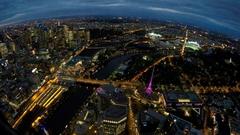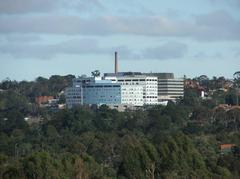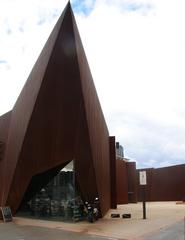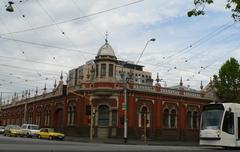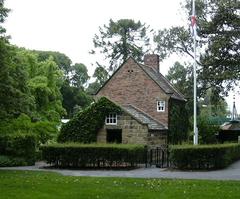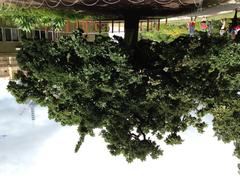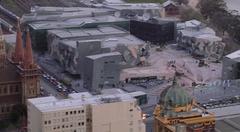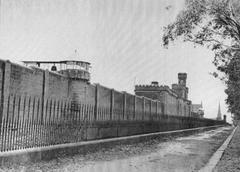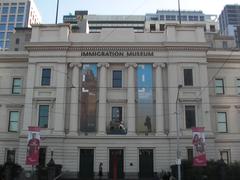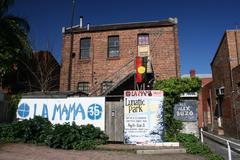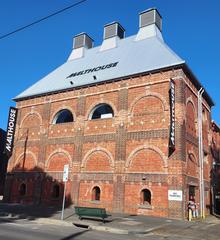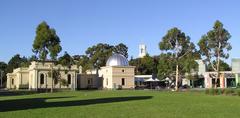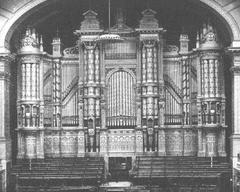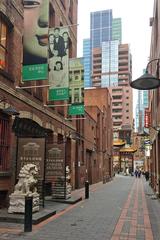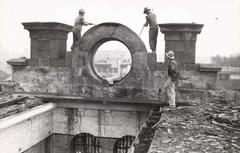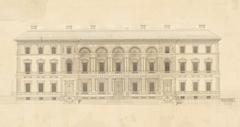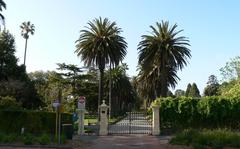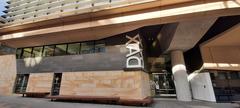Shrine of Remembrance: Visiting Hours, Ticket Information, and Historical Significance in Melbourne
Date: 18/07/2024
Introduction
The Shrine of Remembrance, an iconic historic landmark in Melbourne, Australia, stands as a solemn tribute to the valor and sacrifices of Australian soldiers. This monumental site, deeply rooted in the collective consciousness of the nation, was conceived in the aftermath of World War I to honor the 89,100 Victorian men and women who served. Designed by architects Phillip Hudson and James Wardrop, both veterans themselves, the Shrine’s classical Greek-inspired architecture and symbolic elements underscore its profound historical and cultural significance (source).
Beyond its architectural grandeur, the Shrine serves as a living memorial, actively engaging contemporary Australia through educational programs, commemorative services, and exhibitions. As a focal point for national remembrance, it hosts significant events like ANZAC Day and Remembrance Day, drawing thousands of visitors annually to reflect on the human cost of war and the enduring spirit of peace (source). This guide offers a comprehensive look into its history, architectural marvels, visitor information, and nearby attractions, ensuring a fulfilling and respectful visit to this hallowed site.
Table of Contents
- [History of the Shrine of Remembrance](#history-of-the-shrine-of-remembrancehistory-of-the-shrine-of-remembrance)
- [A Vision Born of Loss](#a-vision-born-of-lossa-vision-born-of-loss)
- [A Design Competition and a Grand Vision](#a-design-competition-and-a-grand-visiona-design-competition-and-a-grand-vision)
- [Construction and Dedication](#construction-and-dedicationconstruction-and-dedication)
- [The Shrine’s Enduring Significance](#the-shrines-enduring-significancethe-shrines-enduring-significance)
- [Visitor Information](#visitor-informationvisitor-information)
- [Visiting Hours](#visiting-hoursvisiting-hours)
- [Tickets and Admission](#tickets-and-admissiontickets-and-admission)
- [Travel Tips and Nearby Attractions](#travel-tips-and-nearby-attractionstravel-tips-and-nearby-attractions)
- [Accessibility](#accessibilityaccessibility)
- [More Than Just a Memorial](#more-than-just-a-memorialmore-than-just-a-memorial)
- [Architectural Marvels of the Shrine of Remembrance](#architectural-marvels-of-the-shrine-of-remembrancearchitectural-marvels-of-the-shrine-of-remembrance)
- [Classical Design and Inspiration](#classical-design-and-inspirationclassical-design-and-inspiration)
- [Symbolic Elements](#symbolic-elementssymbolic-elements)
- [Materials and Construction](#materials-and-constructionmaterials-and-construction)
- [Interior Spaces and Decoration](#interior-spaces-and-decorationinterior-spaces-and-decoration)
- [The Surrounding Landscape](#the-surrounding-landscapethe-surrounding-landscape)
- [FAQs](#faqsfaqs)
- [Conclusion](#conclusionconclusion)
- [References](#referencesreferences)
History of the Shrine of Remembrance
A Vision Born of Loss
The Shrine’s genesis lies in the aftermath of World War I, a conflict that profoundly impacted Australia. With over 60,000 Australian soldiers losing their lives and many more bearing physical and emotional scars, there was a collective desire to honor their sacrifice and create a lasting memorial. The idea for a “sacred place” of remembrance was first publicly voiced in 1918 by Sir John Monash, a prominent Australian general who had witnessed the horrors of the Western Front firsthand. His vision resonated deeply with a nation grappling with loss and seeking solace.
A Design Competition and a Grand Vision
To find a design befitting the solemnity of the purpose, a competition was held in 1922. From 83 submissions, the design by architects Phillip Hudson and James Wardrop, both veterans themselves, was chosen. Their design, inspired by the Mausoleum at Halicarnassus and the Parthenon in Athens, aimed to evoke a sense of timeless grandeur and classical elegance.
Construction and Dedication
The foundation stone of the Shrine was laid on June 19, 1927, by the Duke of York (later King George VI), marking the beginning of a construction process that would span several years. The Great Depression posed significant challenges, delaying the completion. Finally, on November 11, 1934, the Shrine of Remembrance was dedicated in a solemn ceremony attended by a crowd of over 300,000 people – a testament to the profound significance the monument held for the nation.
The Shrine’s Enduring Significance
The Shrine of Remembrance has served as a focal point for remembrance and commemoration ever since its dedication. Every year, on ANZAC Day (April 25th) – the anniversary of the landing of Australian and New Zealand troops at Gallipoli during World War I – a dawn service is held at the Shrine, drawing hundreds of thousands of people to pay their respects. Beyond ANZAC Day, the Shrine acts as a site of remembrance throughout the year, hosting commemorative services for other conflicts and peacekeeping operations in which Australians have served. It stands as a solemn reminder of the human cost of war and the importance of striving for peace.
Visitor Information
Visiting Hours
Visitors can explore the Shrine of Remembrance daily from 10 AM to 5 PM, except on Christmas Day and Good Friday. Special extended hours apply on ANZAC Day and Remembrance Day.
Tickets and Admission
Admission to the Shrine of Remembrance is free, though donations are welcomed to support its upkeep and educational programs. Special guided tour tickets are available for those who wish to gain deeper insights into the Shrine’s history and significance.
Travel Tips and Nearby Attractions
Getting There
The Shrine is easily accessible via public transport. Trams 3, 5, 6, 16, 64, 67, and 72 stop nearby, and there is limited on-site parking for those driving.
Nearby Attractions
Located in the heart of Melbourne, the Shrine is close to other significant historical sites such as the Royal Botanic Gardens, the National Gallery of Victoria, and Federation Square. Visitors can easily make a day of exploring these cultural landmarks.
Accessibility
The Shrine of Remembrance is committed to being accessible to all visitors. There are ramps, accessible restrooms, and hearing loops available to ensure an inclusive experience for everyone.
More Than Just a Memorial
The Shrine of Remembrance is not just a monument to the past; it’s a living memorial that continues to evolve and engage with contemporary Australia. The addition of the Remembrance Gallery in 1998 provided a space to explore the personal stories of Australians who have served in various conflicts, offering a deeper understanding of the human impact of war. The Shrine also plays an active role in educating younger generations about the significance of remembrance and the importance of peace. Through school visits, exhibitions, and public programs, it ensures that the sacrifices of the past are not forgotten and that the lessons learned continue to resonate with future generations.
Architectural Marvels of the Shrine of Remembrance
Classical Design and Inspiration
The Shrine’s design is rooted in classical Greek architecture, evident in its symmetrical layout, the use of the octagonal shape, and the prominent peristyle.
- The Octagon - The Shrine’s octagonal shape, with its eight equal sides, symbolizes the eight points of the compass, representing the directions from which Australian soldiers came to serve in World War I (source).
- The Peristyle - The building is surrounded by a majestic colonnade, known as a peristyle, consisting of 48 fluted Doric columns. These columns, each representing a thousand fallen soldiers from Victoria, create a sense of enclosure and solemnity (source).
Symbolic Elements
Every element of the Shrine’s design is imbued with meaning, serving as a constant reminder of the sacrifices made during the war.
- The Stone of Remembrance - Located at the heart of the Sanctuary, directly beneath the central dome, lies the Stone of Remembrance. Inscribed with the words “Greater love hath no man,” it marks the point where a ray of sunlight falls at 11 am on November 11th each year – the moment the Armistice was signed (source).
- Eternal Flame - Burning continuously since 1954, the Eternal Flame, located in the Sanctuary, symbolizes the enduring memory of those who served and died (source).
- The Cenotaph - The word “Cenotaph” means “empty tomb.” While the Shrine serves as a memorial, it does not contain any war dead. This design choice emphasizes remembrance for all who served, regardless of their final resting place (source).
Materials and Construction
The Shrine’s construction involved meticulous craftsmanship and the use of materials chosen for their beauty and durability.
- Granite - The Shrine is built primarily of granite sourced from Tynong, Victoria. This hard-wearing stone symbolizes strength, permanence, and the enduring nature of remembrance (source).
- Bronze - Bronze, an alloy of copper and tin, is used extensively throughout the Shrine, particularly for the statues, reliefs, and decorative elements. Its warm, dignified tone complements the granite and adds a sense of solemnity (source).
Interior Spaces and Decoration
The interior of the Shrine is as impressive as its exterior, with spaces designed for contemplation and reflection.
- The Sanctuary - The heart of the Shrine, the Sanctuary, is a dimly lit space that houses the Stone of Remembrance and the Eternal Flame. Its walls are lined with the embroidered silk Panels of Sacrifice, listing the names of over 85,000 Victorians who enlisted for World War I (source).
- The Crypt - Located beneath the Sanctuary, the Crypt houses the Shrine’s collection of over 800 objects related to Australian conflicts. It provides a tangible link to the past and offers insights into the experiences of those who served (source).
- The Balcony - The Balcony, encircling the Sanctuary, provides a vantage point to look down upon the Stone of Remembrance and observe the ray of sunlight on Remembrance Day. It offers a moment of quiet contemplation amidst the grandeur of the space (source).
The Surrounding Landscape
The Shrine’s location atop a hill in Kings Domain Gardens was carefully chosen to enhance its visual impact and symbolic meaning.
- Prominent Location - Situated on a hill, the Shrine dominates the Melbourne skyline, serving as a constant reminder of the sacrifices made in past conflicts (source).
- Axis of Remembrance - The Shrine is strategically positioned at one end of Melbourne’s ceremonial boulevard, creating a symbolic “Axis of Remembrance” that connects it to the heart of the city (source).
- Gardens of Remembrance - The surrounding gardens, designed by landscape architect Edna Walling, provide a tranquil setting for reflection and remembrance. The various trees and plants represent different regions where Australians served during wartime (source).
FAQs
- What are the Shrine of Remembrance visiting hours?
- The Shrine is open daily from 10 AM to 5 PM, except on Christmas Day and Good Friday. Special hours apply on ANZAC Day and Remembrance Day.
- How much do tickets to the Shrine of Remembrance cost?
- Admission is free, though donations are welcome. Guided tour tickets are available for a fee.
- Are there guided tours available at the Shrine of Remembrance?
- Yes, guided tours are available and provide in-depth insights into the history and architecture of the Shrine.
Conclusion
The Shrine of Remembrance stands as a powerful symbol of Australian identity, reflecting the nation’s respect for its veterans and its commitment to peace. It’s a place of reflection, remembrance, and hope, reminding us of the enduring human spirit in the face of adversity. Visitors are encouraged to immerse themselves in the Shrine’s profound legacy, taking time to explore its serene surroundings and nearby cultural landmarks (source). For more information on planning your visit, check the official Shrine of Remembrance website and stay connected through social media for updates on events and exhibitions.
References
- Discover the Shrine of Remembrance - History, Visiting Hours, and Tickets, 2023, Shrine of Remembrance (source)
- Exploring the Architectural Marvels of the Shrine of Remembrance in Melbourne, 2023, Shrine of Remembrance (source)
- Visiting the Shrine of Remembrance - Hours, Tickets, and Nearby Attractions in Melbourne, 2023, Shrine of Remembrance (source)


